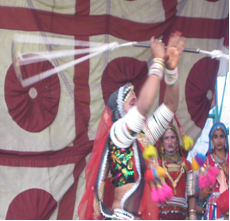Rajasthan is known for its spirit of celebration. Each region in Rajasthan has its own form of folk entertainment. In most parts entertainment is provided by professional communities of entertainers whose livelihood depends on it, and who have evolved their respective arts into fine forms. Certainly the patronage of the former royal families in the past helped to support the entertainers.
There have always been several communities of artists & performers in Rajasthan, and they have served both at the royal court and common men’s courtyard as they traveled through the state, recounting tales of passion, valor, knightly prowess, chivalry and the rhapsody of the matchless romance of the folk heroes & heroines – a legendary of sagas and infinite charm of Rajasthan. For many of these communities this has been the only source of livelihood and they have not owned land, and settled, but chosen to lead their lives as minstrels. It is believed that all the gypsy communities of the world are supposed to have made their way around the globe from Rajasthan..
Traditionally, families would invite these dancers, singers and musicians at family celebrations whether births or marriages or other festivities. No Rajasthani marriage is for example, complete unless led by the DHOLI/MANAGANIYARS/LANGAS with their simple drums (Dholak) and accompanied by the deep bass of their voice.
Professional entertainers who performed a particular type of dance, or entertainment, are to be found in the more fertile tracts of eastern Rajasthan. These include the Bhopas (who sing in praise of PABUJI RATHORE the folk hero from Marwar, accompanied by the PHAD paintings), the Kachhi Ghodi Dancers, and the puppeteers.
Some of the best known entertainers of Rajasthan are the KALBELIYA Dancers with their rhythmic snake dances. The LANGAS of Jodhpur & Barmer districts and the MANAGANIYARS of Jaisalmer district have traveled all over the world to entertain audiences, so simple and uncomplicated, but compelling, is their repertoire. In recent years however, these performer have become more widespread so that their regional distinction is beginning to wear off.
Celebrations in Rajasthan range from the religious to the popular, linked with commerce, as in the case of the camel and cattle fairs. In more recent years, the tourism department of Rajasthan too has initiated a number of fairs and festivals in an attempt to showcase the performing arts of Rajasthan, region wise. Amazingly, though the soil throbs with the sounds of celebration, its vibrant chords require little sophistry apart from the simple, unsophisticated instruments that include the RAVANHATHA (a stringed instrument), the MORCHANG (a Jewish harp), the BANKIA (Trumpet), ALGOZA (the Twin flutes), the DUFF (Tambourine), and the amazingly innocuous MATKA (earthen pitcher) which is flipped over to play the most amazingly mesmeric beat that resound with the pulse of Rajasthan.













